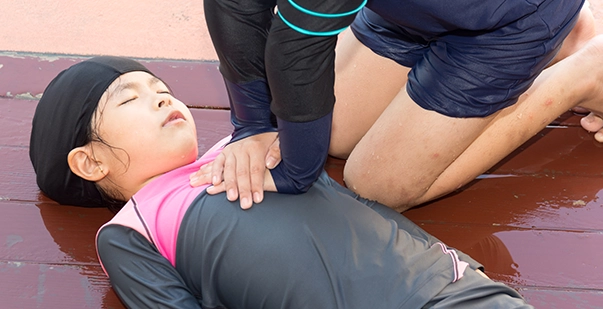Table of Contents:
- Introduction
- 5 Essential Initial Actions to Follow After Rescue
- What to Do After Initial First Aid?
- Preventive Measures and Safety Tips
- Final Thoughts
A relaxing day at the pool can take a sudden turn when someone goes under the water and doesn’t come up. In that crucial moment, the actions you take could make all the difference. With drowning being the third leading cause of unintentional injury deaths worldwide, understanding how to provide first aid for drowning is essential. According to the World Health Organization, approximately 300,000 people die from drowning every year. Knowing what steps to take when you’ve rescued someone from drowning can be life-saving.
In this blog, we’ll walk you through the first aid for drowning step by step so that you can provide effective first aid to a person who has been saved from drowning.
Master ACLS Now
Get ACLS certified with confidence
5 Essential Initial Actions to Follow After Rescue
After rescuing someone from drowning, the immediate actions you take are crucial. In these critical moments, assessing the person’s condition and providing appropriate care can greatly impact their chances of recovery. Below are some of the first aid drowning steps you can follow:
-
Check for Responsiveness
The first step in providing drowning first aid is to determine if the person is conscious. Gently shake their shoulders and call out to them. If they do not respond, proceed with further steps immediately.
-
Call for Emergency Assistance
Even if the person appears to be recovering, it is crucial to call emergency services. Provide clear and concise information about the situation and your location. Medical professionals need to assess and treat any potential complications.
-
Assessing Breathing and Circulation
To assess if the person is breathing, place your ear close to their mouth and nose. Observe their chest to see if it rises and falls. Look for any signs of breathing, such as chest movement or sounds of breath. If the person is not breathing or has irregular breathing, immediate action is required.
-
Perform Rescue Breaths
If the person is not breathing, start with rescue breaths. First, tilt their head back slightly to open the airway. Pinch their nose shut and cover their mouth with yours, creating a tight seal. Give two breaths, each lasting about one second, ensuring that the chest rises with each breath.
-
Chest Compressions
If the person does not have a pulse, begin chest compressions. Place the heel of one hand on the center of the person’s chest, between the nipples. Place your other hand on top of the first hand and interlock your fingers. Push down hard and fast, compressing the chest by about 2 inches (5 cm) deep at a rate of 100-120 compressions per minute. Continue until help arrives or the person shows signs of recovery.
Also Read: First Aid For An Unconscious Person
What to do After Initial First Aid?
Once you have administered the initial first aid, if someone is drowning, focus on ongoing care and monitoring. These subsequent actions ensure that any immediate needs are addressed and help prevent potential complications. Let us look at the steps to take after the initial response to support the person’s recovery until professional medical help arrives:
-
Place in Recovery Position
Once the person starts breathing normally, carefully roll them onto their side. Ensure their head is tilted slightly back to keep the airway open. This position helps prevent choking and allows any remaining water to drain from the mouth. Place a rolled-up towel or clothing under their head for support.
-
Monitor Their Condition
Keep a close watch on the person’s breathing and responsiveness. If they stop breathing or lose consciousness again, repeat the steps for rescue breaths and chest compressions. Continue to monitor their condition until emergency services arrive.
-
Addressing Potential Complications
A person who has been rescued from drowning may experience secondary complications, such as water in the lungs. This can lead to coughing, difficulty breathing, or chest pain. Be vigilant for these symptoms and inform medical professionals upon their arrival.
-
Recognize Symptoms
If the person has been in cold water, they may be at risk for hypothermia. Symptoms include shivering, confusion, and pale or bluish skin. To treat hypothermia, keep the person warm by covering them with blankets or dry clothing. Avoid using direct heat sources, such as hot water or heating pads, as this can cause burns or further complications.
-
Offer Emotional Comfort
Drowning can be a traumatic experience. Offer comfort and reassurance to the person, and remain calm to help them feel more secure. They may need emotional support and counseling to cope with the psychological effects of the incident. Encourage them to seek professional help if necessary.
Preventive Measures and Safety Tips
Preventing drowning incidents is as crucial as knowing first aid. Proper awareness and safety measures can significantly lessen the chance of such emergencies. Implementing correct approaches ensures a safer environment and also reduces the chances of drowning.
-
Understand Water Safety
Preventing drowning incidents is crucial. Always supervise children around water, ensure proper safety equipment is used, and educate individuals about water safety. Learning swimming and water survival skills can significantly reduce the risk of drowning.
-
Regular First Aid Training
Regularly updating your knowledge of first aid for drowning children will ensure that you are prepared for emergencies. Courses in first aid, CPR, and basic life support can provide valuable skills and knowledge to handle such situations effectively.
-
Install and Maintain Safety Barriers
Proper safety barriers are crucial in preventing drowning accidents. Install fences around swimming pools with self-closing and self-latching gates to keep unsupervised children away from the water. Ensure that these barriers are well-maintained and comply with local safety regulations. Regularly check for any wear and tear or potential breaches to keep the area secure.
-
Implement Water Safety Rules
Establish and enforce clear water safety rules for your family and guests. Set guidelines for swimming areas, such as no running near the pool, no diving in shallow water, and no swimming alone. Educate everyone about the importance of adhering to these rules to create a safer environment around water. Consistent reinforcement of these rules helps prevent accidents and promotes a culture of safety.
Also Read: What Steps Should You Follow For Any Environmental Emergency
Final Thoughts
Drowning can be a terrifying experience, and knowing how to respond effectively can make all the difference. If someone is drowning, your first response should be first aid for drowning. Your immediate and correct actions are crucial. Prevention is also key, which ensures that safety measures are in place and can greatly reduce the risk of drowning incidents.
Explore first aid training opportunities and reinforce water safety practices to be equipped for emergencies and ensure the well-being of those around you. Timely first aid for drowning can save a precious life.







